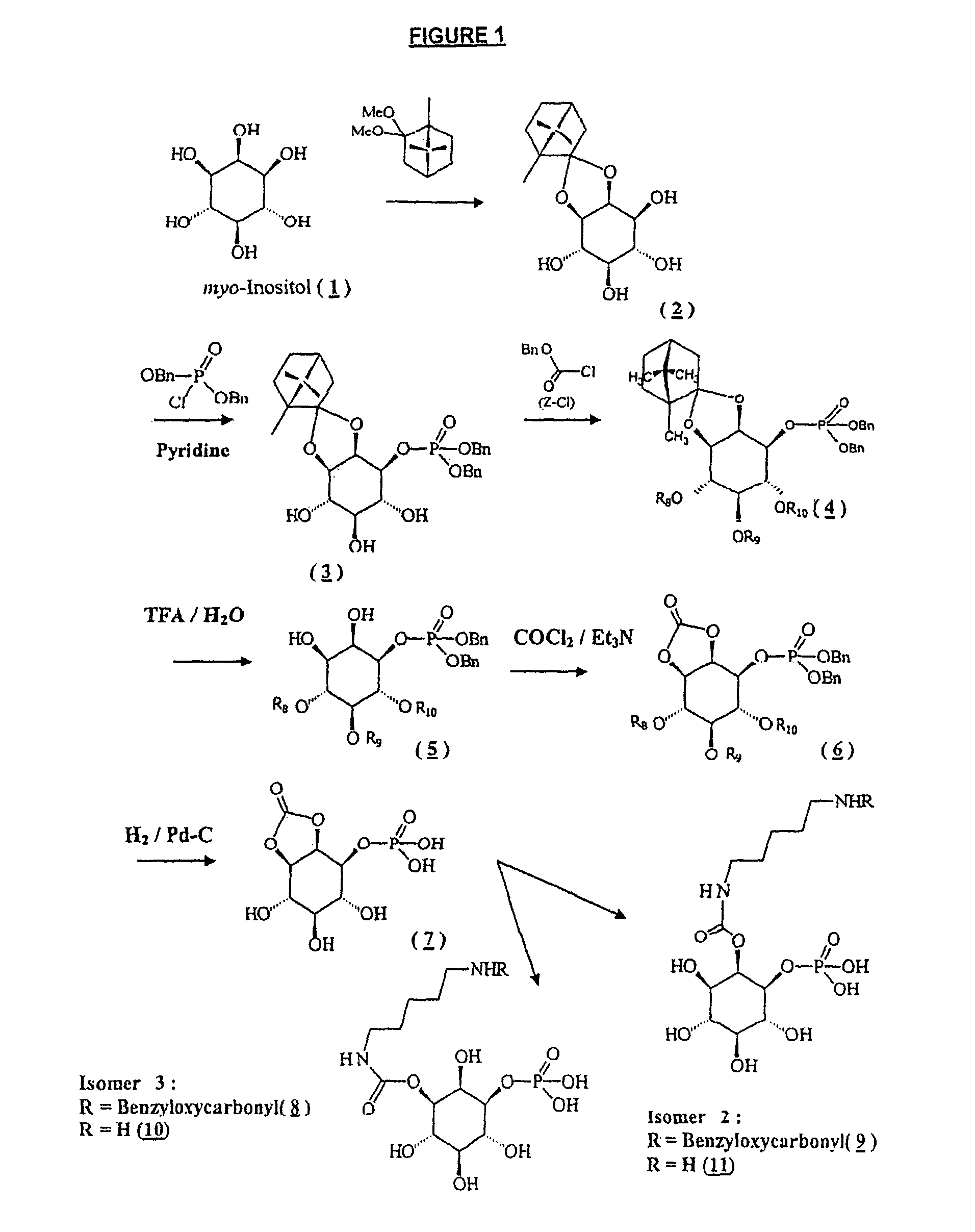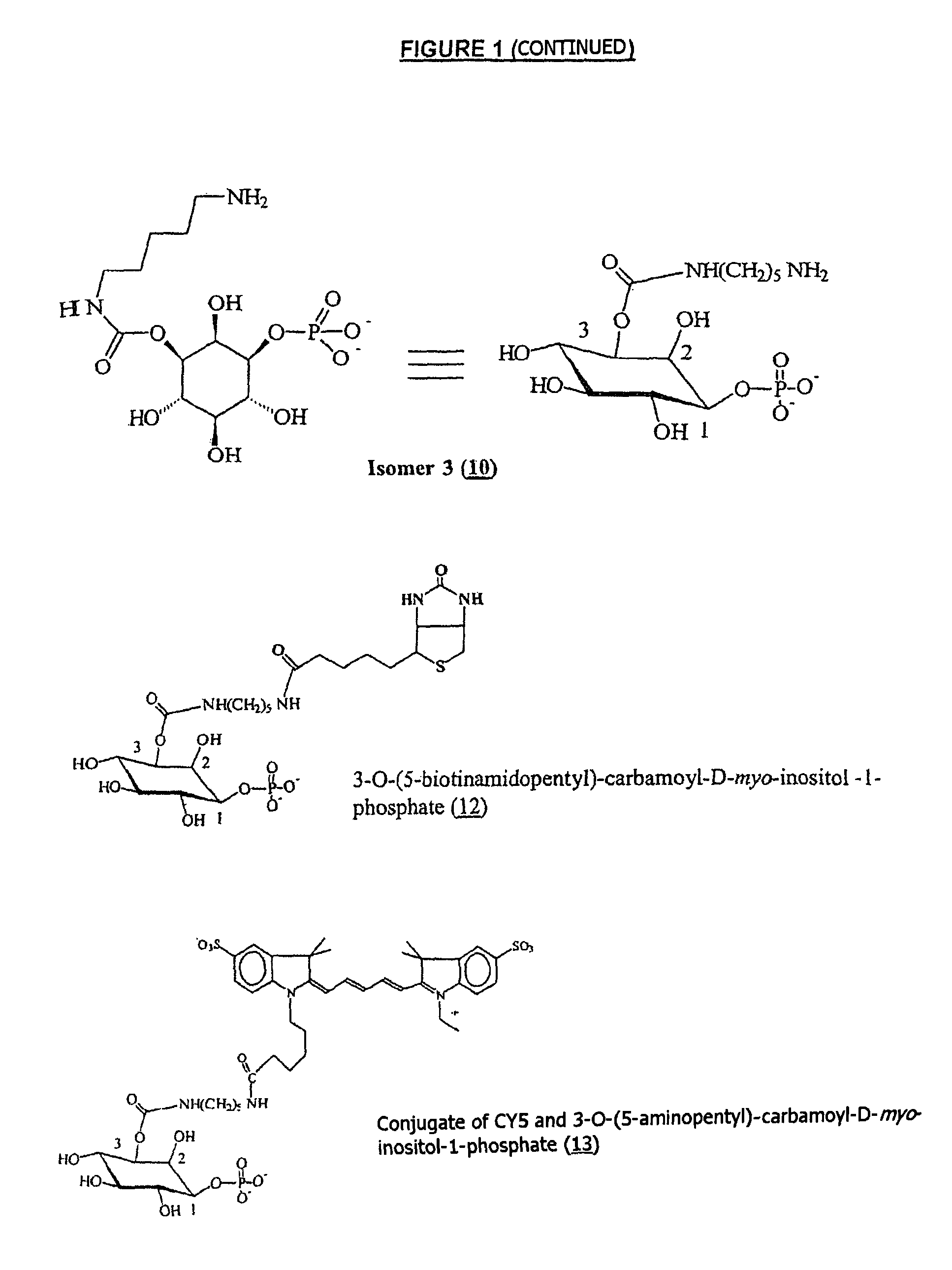Inositol-phosphate derivatives and method of detecting inositol-1-phosphate
a technology of inositol-1-phosphate and inositol phosphate, which is applied in the direction of material analysis, material testing goods, instruments, etc., can solve the problems of lack of selectivity, difficult control, and inability to perform a large number of simultaneous assays
- Summary
- Abstract
- Description
- Claims
- Application Information
AI Technical Summary
Problems solved by technology
Method used
Image
Examples
example 1
Synthesis of 2,3-O-[(1R,4R)-1,7,7-trimethylbicyclo[2.2.1]-hept-2-ylidene]-D-myo-inositol (inositol-camphor) (Compound 2)
[0317]Commercial myo-inositol (compound 1) (4.2 g) is suspended in anhydrous DMSO (50 ml) with D-camphor dimethylacetal (9.3 g). The mixture is stirred at 50° C. for 3 h, neutralized with triethylamine and concentrated under vacuum. The residue is taken up in a solution containing 18 mg of para-toluenesulfonic acid hydrate in a mixture of methanol and chloroform. After stirring overnight at 20° C., triethylamine is added and the precipitate obtained is filtered, washed with chloroform and then suspended in water, stirred for 15 min, and then filtered. The precipitate is washed with water and chloroform and then dried.
[0318]Yield 4.8 g (65%).
[0319]TLC (silica) Rf=0.51 (10% MeOH / AcOEt).
[0320]MS-ESI(+): m / z=315 [M+H]+, 337 [M+Na]+
[0321][α]D=+19.3 (c=1, DMSO)
example 2
Synthesis of [1R-(1α,2α,4α)-2,3-O-(1R,4R)-1,7,7-trimethylbicyclo[2.2.1]-hept-2-ylidene]-1-[bis(phenylmethyl)phosphate]-myo-inositol (Compound 3)
[0322]Compound 2 of Example 1 (2.5 g) is made anhydrous and taken up in anhydrous pyridine (30 ml). The solution is cooled (4° C.) under a nitrogen atmosphere and dibenzyl phosphochloridate (3.5 g) is added dropwise, with stirring. After stirring for 3 h, the mixture is diluted with ethyl acetate and then washed with a saturated aqueous sodium hydrogen carbonate solution. The organic phase is concentrated and then coevaporated with toluene, the residue is purified by chromatography on a silica column (2-15% MeOH / CH2Cl2). The desired compound is then crystallized from an AcOEt / heptane (1:4) mixture.
[0323]Yield 1.4 g (30%).
[0324]TLC (silica) Rf=0.25 (5% MeOH / AcOEt).
[0325][α]D=−8.3 (c=1, CHCl3).
[0326]31P NMR (CDCl3): δ (ppm)=−1.61.
example 3
Synthesis of 4,5,6-tri-O-phenylmethyloxycarbonyl-[1R-(1α,2α,4α)-2,3-O-[(1R,4R)-1,7,7-trimethylbicyclo[2.2.1]-hept-2-ylidene]-1-[bis(phenyl-methyl)phosphate]-D-myo-inositol (Compound 4, Z=benzyloxycarbonyl)
[0327]Compound 3 of Example 2 (0.7 g) is taken up in dichloromethane, and then triethylamine (340 μl) and DMAP (6 mg) are added and the stirred solution is cooled (0° C.) under nitrogen. 1.04 ml of benzyloxycarbonyl chloride is added over a period of 30 min and then the mixture is kept stirring for 18 h at room temperature. The reaction mixture is washed with an aqueous sodium hydrogen carbonate solution (at 10%) and then with a saturated NaCl solution; the organic phase is concentrated under vacuum and the residue purified by chromatography on a silica column (2-10% AcOEt / toluene). The desired compound is obtained in the form of a gum.
[0328]Yield 0.7 g (57%).
[0329]TLC (silica) Rf=0.49 (20% AcOEt / toluene).
[0330][α]D=−19.6 (c=1, CHCl3).
PUM
| Property | Measurement | Unit |
|---|---|---|
| pH | aaaaa | aaaaa |
| pH | aaaaa | aaaaa |
| pH | aaaaa | aaaaa |
Abstract
Description
Claims
Application Information
 Login to View More
Login to View More - R&D
- Intellectual Property
- Life Sciences
- Materials
- Tech Scout
- Unparalleled Data Quality
- Higher Quality Content
- 60% Fewer Hallucinations
Browse by: Latest US Patents, China's latest patents, Technical Efficacy Thesaurus, Application Domain, Technology Topic, Popular Technical Reports.
© 2025 PatSnap. All rights reserved.Legal|Privacy policy|Modern Slavery Act Transparency Statement|Sitemap|About US| Contact US: help@patsnap.com



